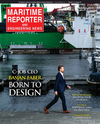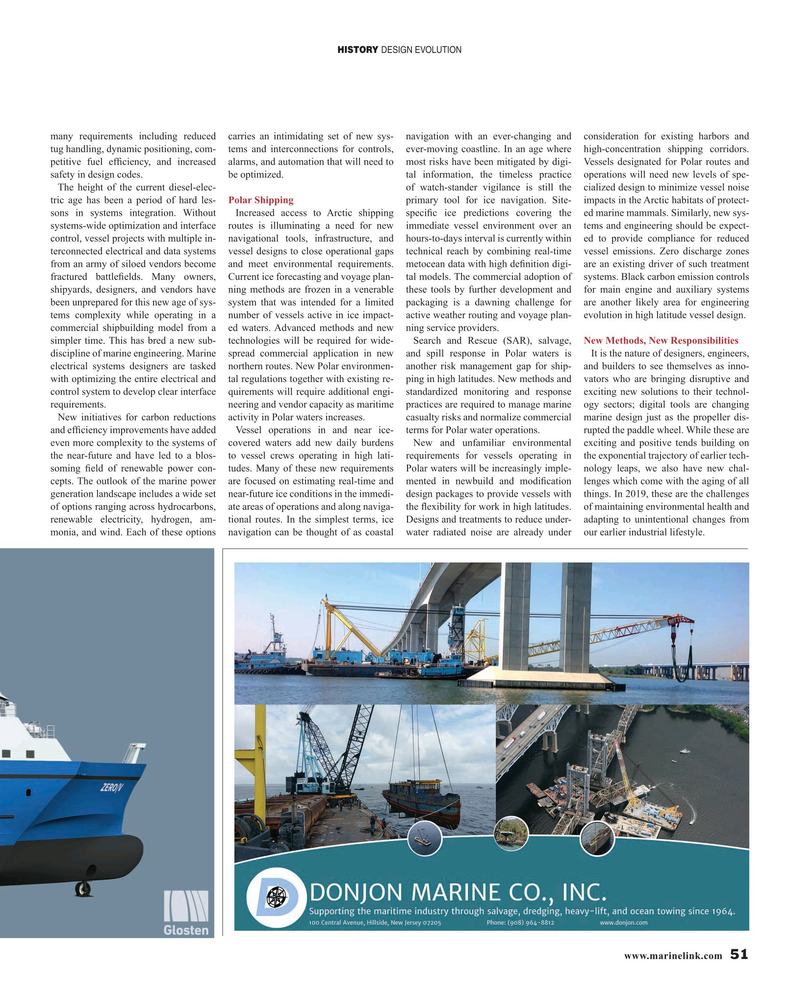
Page 51: of Maritime Reporter Magazine (October 2019)
Marine Design Annual
Read this page in Pdf, Flash or Html5 edition of October 2019 Maritime Reporter Magazine
HISTORY DESIGN EVOLUTION many requirements including reduced carries an intimidating set of new sys- navigation with an ever-changing and consideration for existing harbors and tug handling, dynamic positioning, com- tems and interconnections for controls, ever-moving coastline. In an age where high-concentration shipping corridors. petitive fuel ef? ciency, and increased alarms, and automation that will need to most risks have been mitigated by digi- Vessels designated for Polar routes and safety in design codes. be optimized. tal information, the timeless practice operations will need new levels of spe-
The height of the current diesel-elec- of watch-stander vigilance is still the cialized design to minimize vessel noise tric age has been a period of hard les- Polar Shipping primary tool for ice navigation. Site- impacts in the Arctic habitats of protect- sons in systems integration. Without Increased access to Arctic shipping speci? c ice predictions covering the ed marine mammals. Similarly, new sys- systems-wide optimization and interface routes is illuminating a need for new immediate vessel environment over an tems and engineering should be expect- control, vessel projects with multiple in- navigational tools, infrastructure, and hours-to-days interval is currently within ed to provide compliance for reduced terconnected electrical and data systems vessel designs to close operational gaps technical reach by combining real-time vessel emissions. Zero discharge zones from an army of siloed vendors become and meet environmental requirements. metocean data with high de? nition digi- are an existing driver of such treatment fractured battle? elds. Many owners, Current ice forecasting and voyage plan- tal models. The commercial adoption of systems. Black carbon emission controls shipyards, designers, and vendors have ning methods are frozen in a venerable these tools by further development and for main engine and auxiliary systems been unprepared for this new age of sys- system that was intended for a limited packaging is a dawning challenge for are another likely area for engineering tems complexity while operating in a number of vessels active in ice impact- active weather routing and voyage plan- evolution in high latitude vessel design. commercial shipbuilding model from a ed waters. Advanced methods and new ning service providers. simpler time. This has bred a new sub- technologies will be required for wide- Search and Rescue (SAR), salvage, New Methods, New Responsibilities discipline of marine engineering. Marine spread commercial application in new and spill response in Polar waters is It is the nature of designers, engineers, electrical systems designers are tasked northern routes. New Polar environmen- another risk management gap for ship- and builders to see themselves as inno- with optimizing the entire electrical and tal regulations together with existing re- ping in high latitudes. New methods and vators who are bringing disruptive and control system to develop clear interface quirements will require additional engi- standardized monitoring and response exciting new solutions to their technol- requirements. neering and vendor capacity as maritime practices are required to manage marine ogy sectors; digital tools are changing
New initiatives for carbon reductions activity in Polar waters increases. casualty risks and normalize commercial marine design just as the propeller dis- and ef? ciency improvements have added Vessel operations in and near ice- terms for Polar water operations. rupted the paddle wheel. While these are even more complexity to the systems of covered waters add new daily burdens New and unfamiliar environmental exciting and positive tends building on the near-future and have led to a blos- to vessel crews operating in high lati- requirements for vessels operating in the exponential trajectory of earlier tech- soming ? eld of renewable power con- tudes. Many of these new requirements Polar waters will be increasingly imple- nology leaps, we also have new chal- cepts. The outlook of the marine power are focused on estimating real-time and mented in newbuild and modi? cation lenges which come with the aging of all generation landscape includes a wide set near-future ice conditions in the immedi- design packages to provide vessels with things. In 2019, these are the challenges of options ranging across hydrocarbons, ate areas of operations and along naviga- the ? exibility for work in high latitudes. of maintaining environmental health and renewable electricity, hydrogen, am- tional routes. In the simplest terms, ice Designs and treatments to reduce under- adapting to unintentional changes from monia, and wind. Each of these options navigation can be thought of as coastal water radiated noise are already under our earlier industrial lifestyle. www.marinelink.com 51
MR #10 (50-57).indd 51 10/4/2019 11:53:37 AM

 50
50

 52
52
